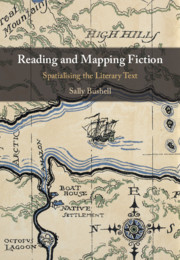Book contents
- Reading and Mapping Fiction
- Reading and Mapping Fiction
- Copyright page
- Dedication
- Contents
- Illustrations
- Acknowledgement of Prior Publications
- Acknowledgements
- Introduction
- 1 A Shifting Relationship: From Literary Geography to Critical Literary Mapping
- 2 Historicising the Fictional Map
- 3 Doubleness and Silence in Adventure and Spy Fiction
- 4 Mapping Murder
- 5 Playspace: Spatialising Children’s Fiction
- 6 Mapping Worlds: Tolkien’s Cartographic Imagination
- 7 Fearing the Map: Representational Priorities and Referential Assumptions
- 8 Reading As Mapping, or, What Cannot Be Visualised
- Bibliography
- Index
Introduction
Published online by Cambridge University Press: 11 June 2020
- Reading and Mapping Fiction
- Reading and Mapping Fiction
- Copyright page
- Dedication
- Contents
- Illustrations
- Acknowledgement of Prior Publications
- Acknowledgements
- Introduction
- 1 A Shifting Relationship: From Literary Geography to Critical Literary Mapping
- 2 Historicising the Fictional Map
- 3 Doubleness and Silence in Adventure and Spy Fiction
- 4 Mapping Murder
- 5 Playspace: Spatialising Children’s Fiction
- 6 Mapping Worlds: Tolkien’s Cartographic Imagination
- 7 Fearing the Map: Representational Priorities and Referential Assumptions
- 8 Reading As Mapping, or, What Cannot Be Visualised
- Bibliography
- Index
Summary
The Introduction affirms the need for a fresh approach to literary mapping centred upon the relationship between map and text as a performative one, brought to life through the actions of the reader. It situates the study in relation to other recent approaches and growing interest in literary and fictional maps. It considers the role and function of a map in a literary work and offers some initial definitions of literary map types. The introduction also outlines the structure of the book and the method in terms of three main sections. The first two chapters establish the conceptual nature of the project, by articulating a critical cartographic approach and then by historicising early examples of fictional maps and explaining the full explosion of the form in the mid-late nineteenth century. Four core chapters then consider maps in relation to newly emerging genres: the adventure story and spy novel; detective fiction; children’s literature; fantasy. The final two chapters of the book turn to the reader. They explore both the absence of maps in the realist novel, in relation to arguments around representation, and the existence, shape and form of the cognitive literary map within the mind. (196)
- Type
- Chapter
- Information
- Reading and Mapping FictionSpatialising the Literary Text, pp. 1 - 15Publisher: Cambridge University PressPrint publication year: 2020

